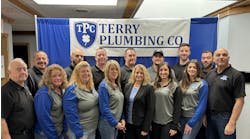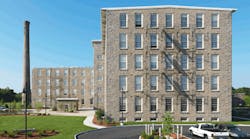Latest from Home
5 Times When Your Business Can Celebrate
Sponsored
TIVERTON, R.I. — Bourne Mill Apartments, an 1881 historic former textile mill here, encompassing approximately 187,000-sq.ft. within eight different buildings, is utilizing energy-efficient HVAC strategies to achieve nearly 37% energy savings over the prevailing national efficiency standard, ASHRAE 90.1-2004.
The $27 million project was recently awarded U.S. Green Building Council LEED Silver certification, making it one of the first mill conversion projects to achieve such a designation. The Bourne Mill Apartments is also on the National Register of Historic Places, and it has added 165 units of mixed-income housing to the area.
To achieve a 30% energy reduction over comparable buildings while maintaining the mill’s historic character, Dellbrook Construction and EA Fish Development, both based in Quincy, Mass., and Boston-based The Architectural Team planned and oversaw a sustainable design and construction approach.
According to Colleen Soden, director of Technical Assistance with The Green Table/NEXUS, the project’s sustainability consultant, strategies employed to achieve the project requirements included reductions of water and energy use and a focus on healthy indoor air quality.
“Considering increasing cost of fuel, the energy efficiency became one of the utmost important goals during the design process,” said Zbigniew Wozny, president of Wozny/Barbar & Associates, the project’s mechanical engineer. “The design team’s intention was to design mechanical systems which would have minimal negative environmental impact. We looked for environmentally conscious technologies suitable for this task.”
In the individual residential units, high-efficiency tankless water heaters by Navien, model CR-180, were installed along with Navien’s Heating Boxes, model HBC-180, an integrated heat transfer control station, to provide both domestic hot water and hot water for the hydronic heating system.
According to Wozny, engineers at Navien told the project team that the Eco Pre-mixed Burner generates at least 20% less CO and about 75% less harmful air pollutants, such as NOx, than other conventional water heaters, and that the condensing water heater decreases around 900-lbs. of CO2 per year as compared to a conventional tank-type water heater of similar size.
“We bore in mind that our mechanical systems shall always be as inconspicuous as possible,” said Wozny. “The heaters are suitable for long venting applications, allowing the vent termination above the roof line.
For the common areas of the buildings, high-efficiency condensing boilers were installed along with energy recovery ventilators to reduce heating demand.
“The boilers in the common area take full advantage of the condensing feature by operating at low temperatures and high efficiencies, and one of the boilers’ features are low CO and NOx emissions,” said Wozny.
Another imperative goal of the project was to provide acceptable indoor air quality by controlling indoor contaminates levels.
According to Wozny, the buildings’ common areas, such as the assembly and meeting rooms, require a significant amount of outside air, but simply increasing outdoor air flow by using traditional HVAC systems frequently leads to energy cost increases.
“Outdoor air treatment can be very expensive,” explained Wozny. “That’s why energy recovery ventilators (ERV) found an application in our project. The ERV transfers sensible and latent heat from one air stream to another. The result is capturing approximately 75% of the energy before it leaves the HVAC system.”
Water conserving measures on site and in the buildings include the use of low-flow plumbing fixtures in all common areas and residential units and the omission of permanent irrigation systems in favor of using local plantings that need little maintenance.
According to John Del Tufo, LEED AP, plumbing engineer of Wozny Barbar & Associates, plumbing fixtures installed in the building include 1.28-gpf water closets, aerators on the lavatory faucets that reduce flow from 1.5 GPM to 1.2 GPM, and 1.5 GPM showerheads, all contributing to the 40% reduction in overall water usage.
"The success of the Bourne Mill project was a direct result of our ongoing 30-year relationship with the EA Fish Companies,” said Michael Binette, AIA, principal, The Architectural Team, Inc. “Based on this relationship, we understood the capabilities and inherent beliefs of this experienced team for such a unique and complex adaptive reuse development. Collaboration and resourcefulness were key elements for achieving LEED Silver certification for this historic mill, a symbol of our firm's 40-year commitment to sustainable design and innovative redevelopment."
Candace Roulo
Candace Roulo, senior editor of CONTRACTOR and graduate of Michigan State University’s College of Communication Arts & Sciences, has 15 years of industry experience in the media and construction industries. She covers a variety of mechanical contracting topics, from sustainable construction practices and policy issues affecting contractors to continuing education for industry professionals and the best business practices that contractors can implement to run successful businesses.


